{ ENGLISH BELOW }
Sí, la obra de Alexandre Farto es resultado del enfrentamiento de fuerzas contrarias que sin embargo se necesitan mutuamente para existir. Contradicción a múltiples niveles (lingüístico, material, humano…). Es un hacer bruco, violento, demoledor, abrupto, aspero, enriscado… en la practica, pero honesto, sincero y de clara intención en el resultado. El uso del barrenado o la perforación permite al autor hacer aflorar lo que el muro atesora en su interior desde el día de su levantamiento, para de seguido dejar que la naturaleza ejerza su influjo sobre él, quedando sumergido en el perpetuo fluir del mundo. “Lo importante es el proceso…”, “…nunca considero que una pieza esté acabada, lo veo más como el final de mi contribución, y entonces la naturaleza puede tomar el relevo y hacer el resto…”, declara. Construye, al destruir el soporte, por ejemplo, retratos de personas anónimas, individuos singulares, poniendo énfasis en la diferencia cultural o de identidades que particulariza a cada una, eliminando el intento de homogenización y uniformidad que representan los personajes irreales y ficciones que copan los mass media o la casi totalidad del espacio público en virtud de la agresiva publicidad que penetra hasta lo mas íntimo de la persona. Esto “Es una manera de empoderar a la persona”, explica. El trabajo de Farto parece desocultar lo que encierra una sociedad urbana perdida en el torbellino del desarrollo económico/social y el progreso e intenta poner de relieve -a golpe de martillo- el proceso de gradual deshumanización en el que occidente se encuentra inmerso.
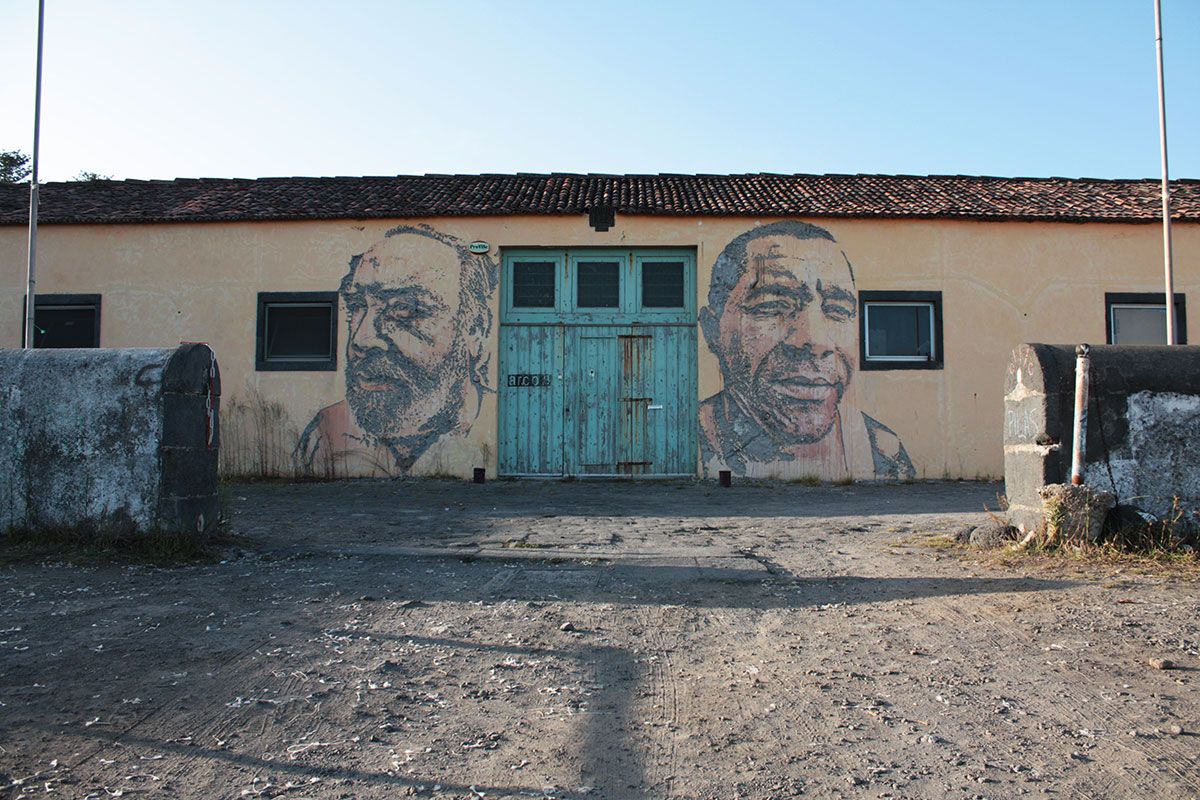
Walk And Talkazores. ph: Jesse James
Para aquellos que aún no lo sepan, ¿quién es Alexandre Farto o Vhils?
Nací en Lisboa, Portugal, en 1987, y crecí en Seixal, una ciudad pequeña industrial que se encuentra justo al otro lado del río. Me gustan las ciudades, los muros, la historia y la naturaleza. También me gusta comer, beber, trabajar y, a veces, hacer volar cosas por los aires.
¿Significa algo Vhils, las letras de tu firma?
No, se me ocurrió al juntar algunas de mis letras favoritas de cuando era un grafitero más activo. Me pareció que quedaban bien y estaba buscando algo que me permitiera escribir rápido.
¿Cuáles son los orígenes de tu trabajo como artista? ¿Dónde y cuándo empezó tu relación con el arte?
Supongo que, como la mayoría de la gente, comencé a dibujar y pintar cuando era pequeño. Recuerdo que dibujaba mucho, incluso en el colegio. Cuando tenía 10 años descubrí el grafiti, y fue eso lo que me llevo al arte. De alguna manera el grafiti fue mi primera escuela de arte, no tenía ninguna conciencia artística cuando comencé. En aquel momento se trataba sobre todo de esa rebeldía adolescente, pero acabó despertando mi interés en el arte y en cómo utilizar el espacio público para crear y comunicar ideas. Empecé a preguntarme qué quería hacer y un día me di cuenta de cómo esas paredes que yo usaba para pintar grafiti estaban formadas por diferentes capas que reflejaban el uso del espacio público a lo largo de los años: murales, posters, grafiti, etc. Comprendí que se puede conocer la historia de una ciudad a través de sus muros, y comencé a interesarme por utilizar esos materiales en mi trabajo.

Shanghai 2012. ph: Joao Moreira
¿Cuál es la intención de tu trabajo y hacia dónde piensas que se dirige?
He estado centrado en desarrollar un reflejo narrativo de la vida en la sociedad urbana contemporánea y del modelo actual de desarrollo socio-económico, tanto lo negativo como lo positivo. Cuestiono su propósito y dirección, su insostenibilidad a largo plazo y cómo está imponiendo cada vez más una realidad uniforme en el mundo y borrando la riqueza de diferencias culturales que solían existir. Mi trabajo habla de identidad humana, de resistencia y de la eliminación de la identidad en este ambiente abrumador. Exploro los intersticios entre las realidades locales y globales.
¿Dónde se encuentran las influencias menos evidentes o reconocibles en tu producción? ¿Qué movimientos o artistas te han influido?
Creo que me ha influenciado más la vida en general que el mundo del arte. Antes de que empezara a hacer grafiti tenía un conocimiento muy limitado de arte. Me gustaba, pero su encanto puede ser muy limitado para un niño. El grafiti abrió mi percepción de la expresión visual, así que mis primeras influencias fueron otros grafiteros y artistas conectados con este movimiento. Incluso hoy creo que le debo más inspiración o influencia a los pequeños detalles mundanos que a un movimiento o artista en particular.

Nuit Blanche. ph: Vhils
Uno de los puntos que me llama la atención de tu trabajo es algo que recuerda la importancia del surrealismo. Situándonos en el punto de partida, en tu trabajo parece darse una relación de sinonimia entre dos conceptos antónimos/antagónicos como son construcción y destrucción. Como si modulases la relación de significados para permitir la analogía entre ambas ideas sin alterarlas ¿Es intencional o una coincidencia resultado de la propia acción?
Mi trabajo aprovecha estos dos conceptos opuestos de construcción y deconstrucción, eso es intencional. Hace uso de ellos al mismo tiempo que resalta la condición de que uno no es posible sin el otro, están interconectados. Son parte de un ciclo que está en el corazón de la vida y de la naturaleza.
Es evidente que tu práctica artística tiene un componente físico considerable, por lo menos en aquellas en las que taladras o barrenas una superficie. Se produce una lucha en toda regla entre el artista y el soporte ¿Qué tiene mayor importancia para ti, el proceso de creación o la obra terminada?
El proceso creativo, sin lugar a dudas. Ahí es donde me gusta centrar mi energía y mi atención. Pero nunca considero que una pieza esté acabada, lo veo más como el final de mi contribución, y entonces la naturaleza puede tomar el relevo y hacer el resto. Dejo que mi obra cambie y evolucione con el tiempo. Me gusta esa participación del tiempo y la naturaleza, pero no lo veo como una lucha. Prefiero pensar que es una manera de trabajar con la naturaleza (y esto incluye evidentemente los materiales), no contra ella.

Nuart 2010. ph: Ian Cox
¿Cuál es tu opinión sobre el arte urbano? ¿Incluirías tu trabajo dentro de esta expresión artística?
No. Sé que es un término práctico, pero creo que es demasiado limitado. ¿Por qué no lo llamamos arte simplemente?
Procedente de grafiti como expresión anónima y considerando la repercusión que estas teniendo a nivel mundial. ¿Te enfrentas a un proceso de institucionalización de tu arte? ¿Te resulta conflictivo? ¿Cómo lo vives?
No, porque para mí son cosas diferentes. Empecé haciendo grafiti y continúo haciéndolo, pero a pesar del hecho de que mi obra le debe mucho al grafiti y ha evolucionado del grafiti, no es grafiti. Mi obra tiene dos partes, arte urbano y arte de galería, pero no creo que haya ningún conflicto entre ellas, son complementarias. Una puede ser más institucional mientras que la otra se mantiene pura e ilegal.
¿Piensas que tomar la calle como centro de exposición aporta algo a la obra que se desactiva en el momento en que se introduce dentro de los márgenes de la institución?
Creo que son contextos muy diferentes que ofrecen distintas ventajas y desventajas. Hay una vitalidad en la calle que no puedes encontrar en la galería, pero la galería ofrece otras posibilidades para desarrollar un trabajo que no puedes encontrar en la calle. Pueden ser complementarios.

Museu da Electricidade. ph: Silvia Lopes
¿Abordas de igual manera una exposición dentro de un recinto que en la calle? ¿Cómo te enfrentas a cada una de estas situaciones?
Cuando las localizaciones son diferentes requieren un acercamiento diferente. A pesar de que ambas compartan esencialmente la misma reflexión con respecto a los temas que exploran, los trabajos siguen procesos distintos y necesitan un acercamiento diferente. La mayoría de los materiales que utilizo para hacer trabajos para la galería vienen de la calle, así que existe una conexión material. Cuando estás trabajando en la calle tu obra está compitiendo con todo el ruido visual que ya existe en la ciudad, así que tienes que crear un impacto mayor. Es un entorno mucho menos, pero estás condicionado también por otros factores como el tiempo. Tienes que trabajar rápido y prestas menos atención a los detalles. La galería ofrece un escenario para un tipo de trabajo más elaborado, donde puedes centrarte en los detalles y crear un diálogo más íntimo con la gente que acude a la galería especialmente para ver tu trabajo, no sólo porque estén pasando por ahí.
¿Tiene importancia el hecho de representar personas anónimas en tus obras? ¿Por qué ellos y no otros?
Sí, es importante. Es parte de la reflexión acerca de la identidad y su disolución debido a la disonancia existente en las sociedades urbanas. Es una manera de empoderar a estas personas. Ofrece un contraste crítico con respecto a las personas irreales que vemos en los medios de comunicación y la publicidad, cuestionando la necesidad de esos iconos en primer lugar. También intenta representar el espacio de la ciudad de una manera más humanizada, pero utilizando gente real. En los proyectos desarrollados con alguna comunidad en especial, como los de Brasil, también sirve para llamar la atención sobre los problemas en los que se centra el proyecto. Para mí los retratos son una forma muy poderosa de expresar la compleja relación que existe entre las personas y el lugar en el que viven. El hecho de estar encerrados con nuestro entorno en este ciclo de influencia recíproca es uno de los temas centrales que he estado explorando con mi trabajo.
Para terminar. ¿Nos podrías contar cuáles son tus proyectos a corto y medio plazo?
Este año ha comenzado bastante bien, estoy ocupado. Ya tengo un buen número de proyectos interesantes esperándome que iré anunciando cuando sea el momento.
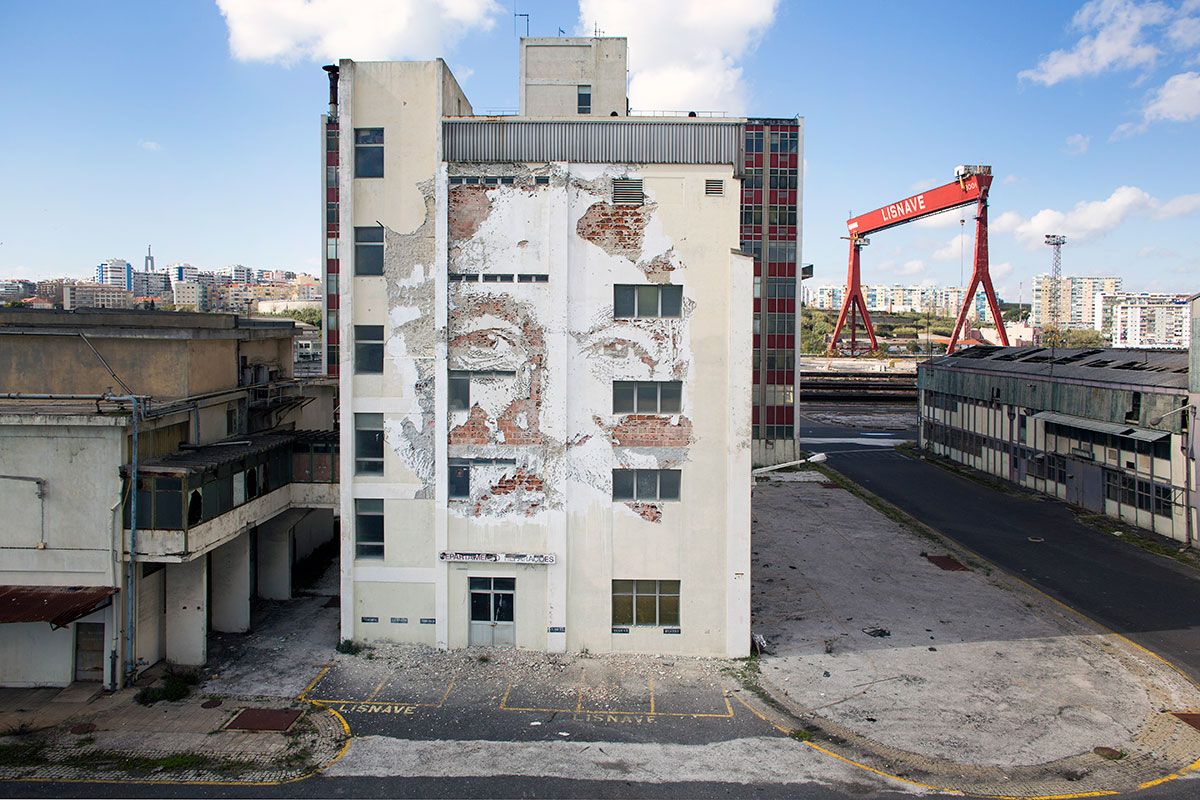
Lisnave 2014

Lisbon 2014. ph: Alexander Silva
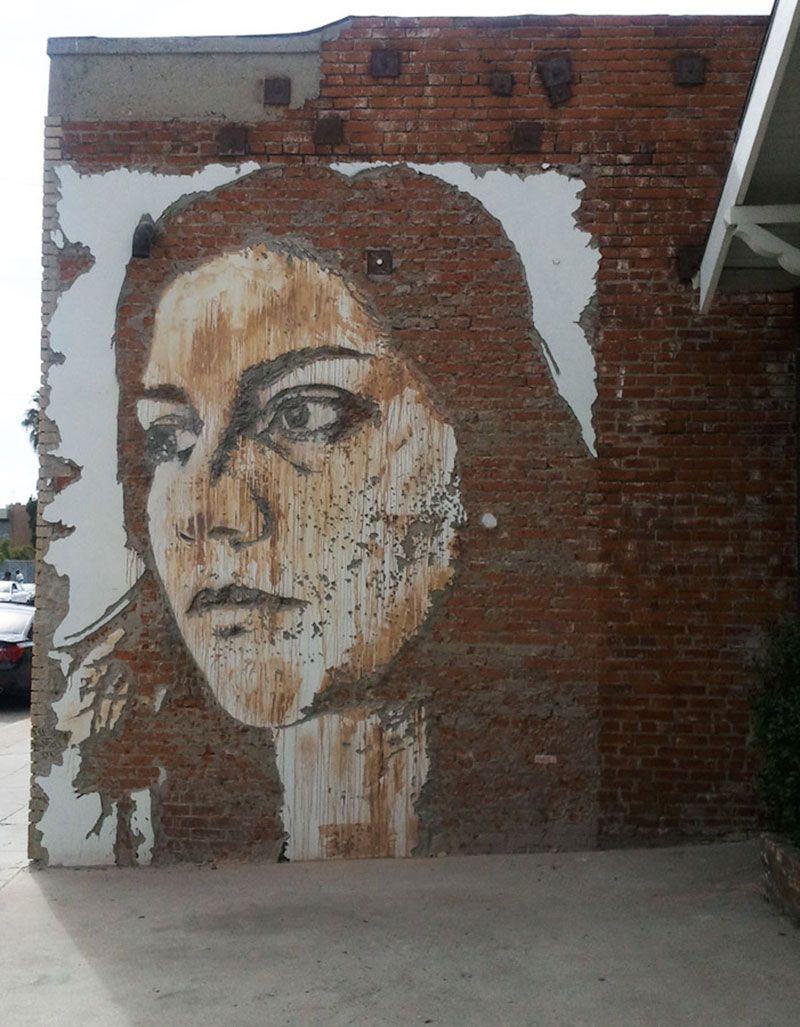
LA 2011

Italy 2010

Centre Pompidou, Paris.

Philadelphia. ph: Steve Weinik

Moscow, Russia
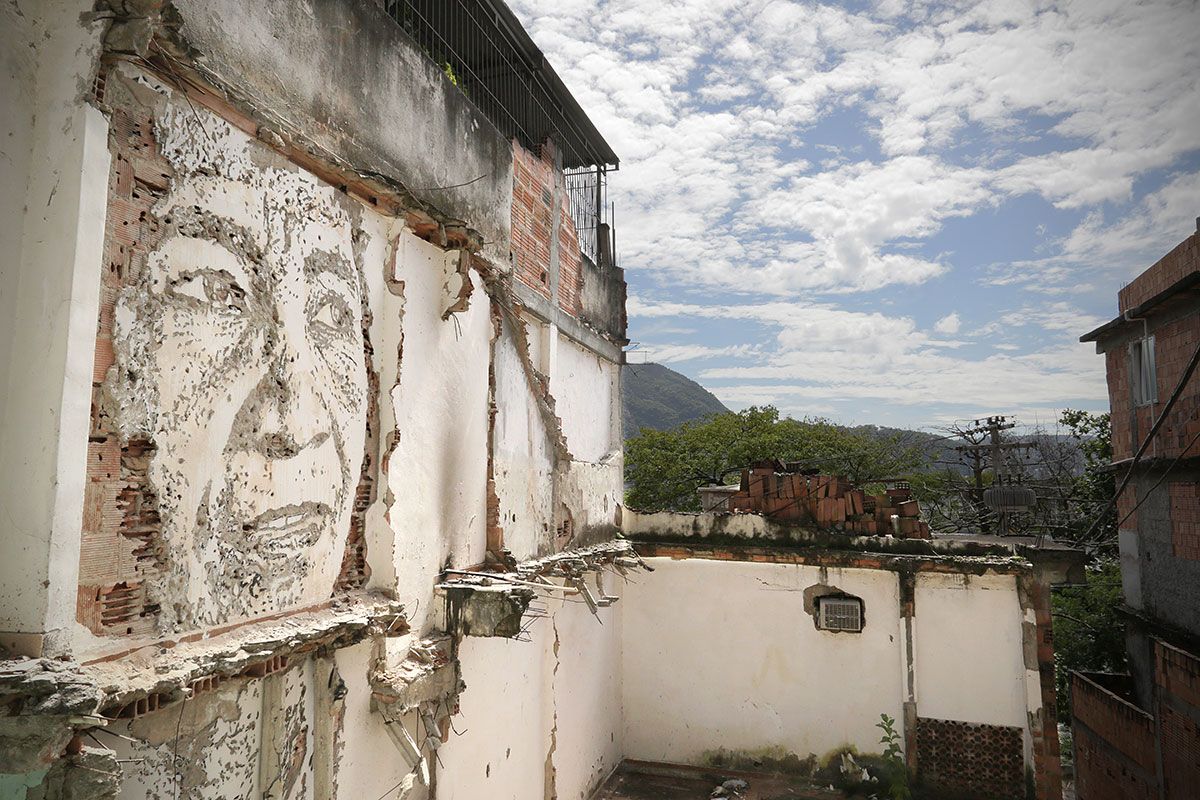
2013 Tabajaras. ph: Joao Retorta

2012 MileStone, Girona. ph: Smart Bastard
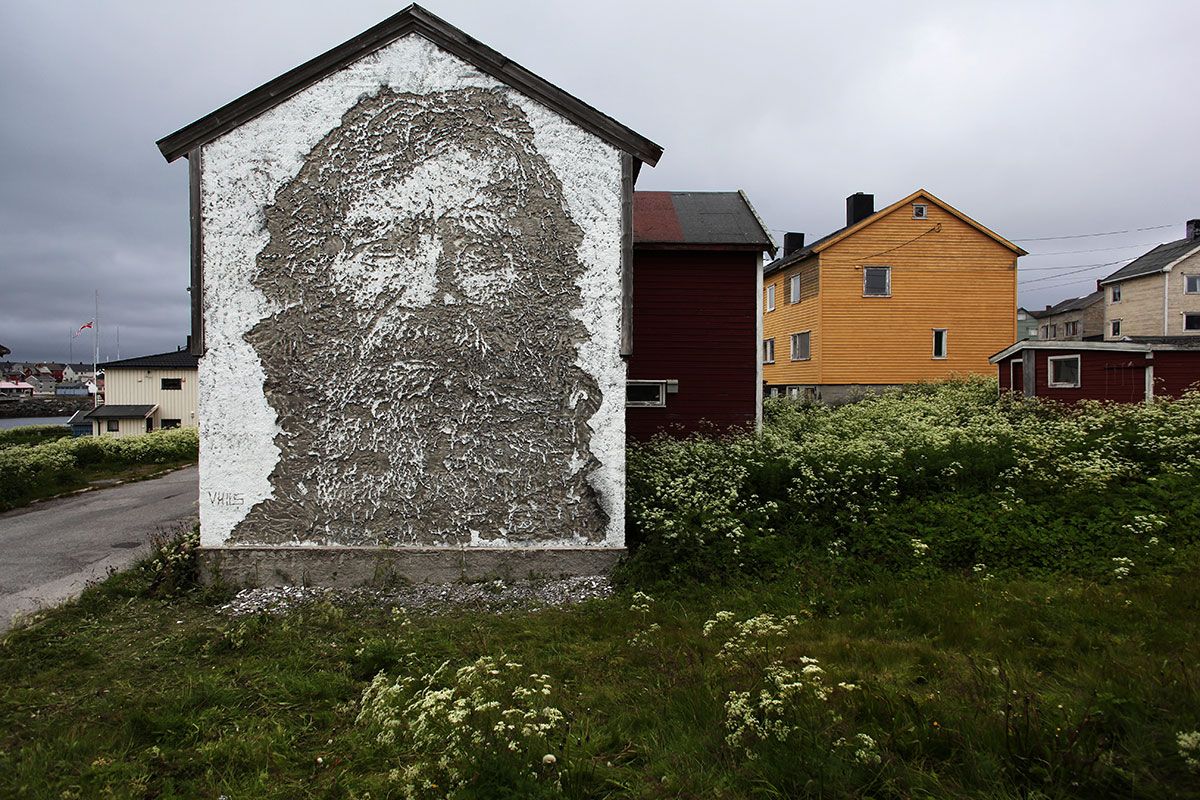
2012 Komafest Vardo, Norway. ph: Smart Bastard
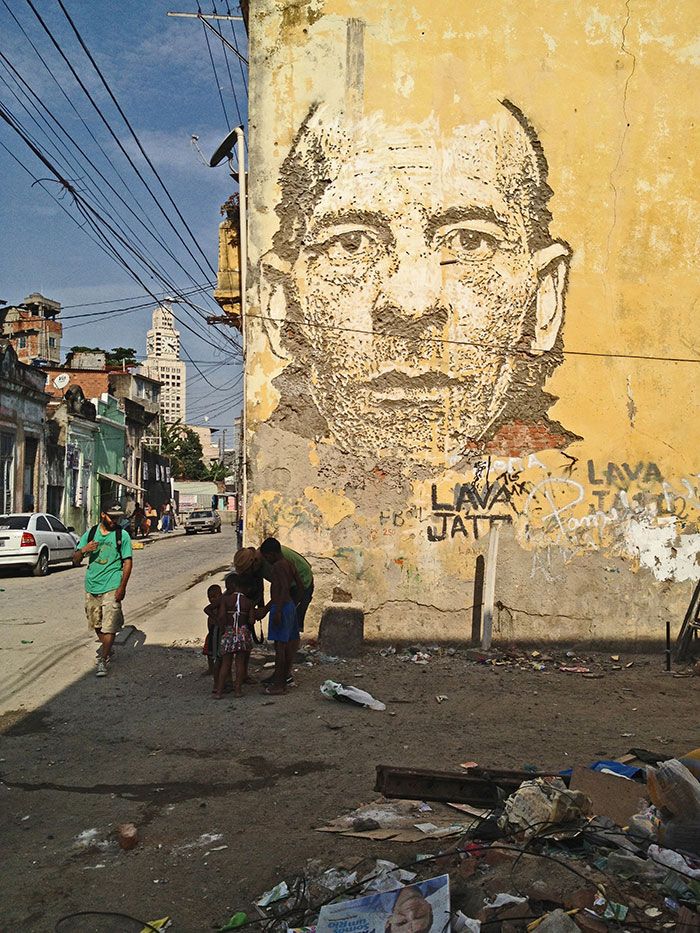
Providencia. ph: Joao Pedro Moreira
(ENGLISH)
VHILS.
The mural deconstruction of Alexandre Farto
The work of Alexandre Farto is indeed the result of the confrontation of opposing forces that nevertheless need each other in order to exist. This is a contradiction on multiple levels: linguistic, material, human. His work is abrupt, violent, devastating, rough and craggy, but also honest, sincere and with a clear intention in the final result. The use of drilling and perforation techniques enables him to bring to the surface what’s hidden inside the wall, to later leave nature do its work and submerge it in the perpetual world flow. “The important part is the process”. “I never view any piece as being finished, I see it more as though that was the end of my contribution and now nature can take over and do the rest”, he claims. When he destroys the foundations of something he builds portraits of anonymous, unique individuals, and emphasizes the cultural differences that make them unique. With this he eliminates the attempt of homogenization and uniformity that the unreal and fictional characters we find in the mass media represent. This homogenization dominates almost every part of the public space under the aggressive advertising that penetrates to the heart of every person. This is “a way to empower the person”, explains Alexandre Farto. His work seems to uncover what’s hidden in an urban society that’s lost in a whirlwind of economic and social development, and attempts to highlight -with the blow of a hammer- the gradual process of dehumanization in which the Western world is immersed.
For those who don’t know it yet, who’s Alexandre Farto (or Vhils)?
I was born in Lisbon, Portugal in 1987 and grew up in Seixal, a small industrialised town that lies just across the river. I like cities and walls, history and nature. I also like to eat, drink, work and, sometimes, to blow things up.
Does your nickname Vhils stand for something?
No, I arrived at it by joining some of my favourite letters when I was an active graffiti writer. They just seemed to work well together and I wanted something that enabled me to write fast.
What are the origins of your work as an artist? When and where did you start having a connection with art?
I suppose that, like most people, I began by drawing and painting as a child. I remember drawing a lot, even in school. Then when I was 10 I discovered graffiti, and it was this interest that led me to art. In many ways graffiti was my first art school, I had no artistic awareness when I first started, it was mainly adolescent rebelliousness but it sparked my interest in art and how to use public space to create and communicate ideas. I started thinking about what I wanted to do and one day I became aware of how these walls I used to paint graffiti on were formed by many layers that reflected the use of public space over the years: murals, posters, graffiti, etc. I realised that a city’s history can be seen on its walls, and I became interested in using this material wealth to work with.
What’s the purpose of your work and where do you think is moving towards?
I’ve been focused on developing a narrative reflection on life in contemporary urban societies and on the current model of socio-economic development, on its positive and negative features. It questions its purpose and direction, how it is unsustainable in the long run and how it is increasingly imposing a uniform reality around the world and effacing the wealth of cultural differences that used to exist. My work speaks of human identity, of resistance and effacement in this overwhelming environment, exploring the interstices between global and local realities.
Where can we see any influences on your work? What movements or artists have influenced you?
I think I’ve been more influenced by life in general than the art world. Before I started writing graffiti I had very limited knowledge of art. I mean, I liked art but its appeal can be very limited to a child. Graffiti opened up my perception to visual expression, so my first influences were other graffiti writers and artists connected with this movement. Even today, I think that I owe more inspiration or influence to small mundane details than any particular movement or artist.
One of the most striking aspects from your work to me is that there is something on it that reminds me to the importance of surrealism. Your work seems to have a relation of synonymy between two antonym/antagonist concepts like construction and deconstruction. Just as if you modulated the relationship of meanings to allow an analogy between both ideas without changing them. Is that intentional or a coincidence as a result of the action itself?
My work does actively embrace these two opposing concepts of construction and deconstruction, which is intentional. It makes use of them while highlighting the condition that one is not possible without the other, they are interconnected, and part of a cycle that lies at the heart of life and nature.
It is evident that your artistic practice has a considerable physic component, at least on those in which you drill the surface, for instance. There is this whole fight between the artist and the medium. What is more important to you, the creative process or the finished work?
The creative process, without a doubt, that is where I like to focus my energy and my attention. But I never view any piece as being finished, I see it more like that was the end of my contribution and now nature can take over and do the rest. Leave it to change and evolve over time. I actively embrace this participation of time and nature, but I don’t see it as a struggle, I prefer to think of it as a way of working with nature (and this obviously includes the materials), not against it.
What do you think about urban art? Would you include your work under this artistic discipline?
No. I know that it is a practical term, but I find it too limiting. Why not just call it Art?
Given that you do graffiti as an anonymous form of expression and the repercussion you are having all over the world. Are you facing an institutionalization of your art? Do you see this as a conflict? How do you see it?
No, because to me these are two different things. I started out with graffiti and I still do it, but despite the fact that my artwork owes a lot to graffiti and evolved from graffiti, it is not graffiti. My artwork also has two sides to it, as I do street work and gallery work, but I see no conflict between them, they are complementary. One can be more institutional while the other remains raw and illegal.
Do you think that using the street as an exhibition venue adds something to the artwork that gets diluted when you display it inside the margins of an institution?
I think they are different contexts that offer both different advantages and disadvantages. There is a vitality in the street which you can never really take into the gallery, but the gallery also offers other possibilities for you to develop work which is lacking in the street. They can be both complementary.
Do you use the same approach for an exhibition inside a venue and one in the street? How do you face each of these situations?
Different locations require different approaches. Despite the fact that both the indoor and outdoor bodies of work share essentially the same reflection regarding the issues they explore, they follow different processes and a different approach. Most of the materials I use to create gallery work come from the street, so there is also a material connection. When you’re working outdoors your work is competing with all the visual noise already present in the city, so you have to create a bigger impact. It’s a much less restrictive environment in some ways, but you’re also conditioned by many other factors, including time. You have to work fast and with less attention to detail. The gallery provides the setting for a more elaborate type of work, where you can focus on detail and create a more intimate dialogue with people who are there specifically to see your work, not just passing by.
Do you think it is important to represent anonymous people on your work? Why do you choose represent these people?
Yes, I do. It’s part of the reflection on identity and its dissolution due to the dissonance present in our urban societies. It’s a way of somehow empowering them. It offers a critical contrast to the unreal people we see in the media and advertising, questioning the need for these icons in the first place. It also aims to render the city space more humanised in some way, but with real people. In projects developed with a specific community, like those in Brazil, it also serves to call attention to the issues the project is focusing on. I see portraits as a very powerful way to express the intricate relationship that exists between people and the places they live in, how all of us are locked in this cycle of reciprocal influence with our surrounding environment, which is one of the main themes I’ve been exploring with my work.
To wrap up, what are your next projects in the short and long term?
This has started out as a good and busy year and I already have a great deal of interesting projects lined up which I’ll be announcing in due time. You can keep track of what I’m doing by following my Instagram and Facebook accounts or website.
www.alexandrefarto.com